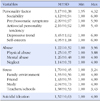Abstract
Purpose
The purpose of this study is to investigate the factors influencing suicidal ideation in middle school students.
Methods
Suicidal Ideation Questionnaire (SIQ) results, personal characteristics, child abuse experiences, and stress were obtained from a sample of 657 middle school students from 3 conveniently selected schools in S city.
Results
Suicidal ideation of participants was positively correlated with child abuse experience, stress, psychosomatic symptoms, antisocial personality and depressive tendencies, whereas sociability and self-esteem were negatively correlated with suicidal ideation. Significant factors influencing suicidal ideation included an antisocial personality tendency, stress related to the family environment, mental abuse, gender (female), depressive trend, running away from home, sociability, and stress related to academic performance. These factors explained 39.9% of the variance.
Conclusion
These results suggest that earlier screening and intervention programs for depression and stress in middle school students will be helpful in reducing suicidal ideation. Further studies are needed in which other strategies that could prevent suicidal ideation in middle school students are examined.
References
1. Cha MY, Kang SH. The effect of life event stress, social support, and depression on high school students' suicidal ideation. Korean J Educ Res. 2010. 48(2):93–122.
2. Cheng ST, Chan AC. Multiple pathways from stress to suicidality and the protective effect of social support in Hong Kong adolescents. Suicide Life Threat Behav. 2007. 37(2):187–196.
3. Chung HK, Ahn OH, Kim KH. Predicting factors on youth suicide impulse. Korean J Youth Stud. 2003. 10(2):107–126.
4. Eaton DK, Kann L, Kinchen S, Ross J, Hawkins J, Harris WA, et al. Youth risk behavior surveillance- United States, 2005. J Sch Health. 2006. 76(7):353–372.
5. Ha YE. A study on actual condition of junior high school students' suicidal ideation. 2000. Seoul: Ewha Womans University;Unpublished master's thesis.
6. Han MH, Yoo AJ. Development of daily Hassels scale for children in Korea. J Korean Home Econ Assoc. 1995. 33(4):49–64.
7. Jang HJ, Lee JY. The development of a child abuse assessment scale. J Korean Counc Child Rights. 1999. 3(1):77–96.

8. Kim BY, Lee CS. Meta-Analysis of variables related to suicidal ideation in adolescents. J Korean Acad Nurs. 2009. 39(5):651–661.

9. Kim HS. The current trend of suicide and its prevention in life stages. J Welf Aged. 2006. 34:271–292.

10. Kim HS, Kim HS. Development of instrument for measuring personality factor related to juvenile delinquency. J Korean Acad Psychiatr Ment Health Nurs. 1999. 8(1):190–201.

11. Kim JY, Chun YK, Lee JS. The Moderating effect of social supportive relationship in the contribution of adolescents' experience of domestic child abuse to suicidal ideation. Yonsei Soc Welf Rev. 2009. 21:119–144.
12. Kim MK, Kim YN, Kim SH. Survey of child and youth safety and health, Seoul. 2011. Retrieved March 21, 2011. from http://www.seoulwomen.or.kr/nhp/dataroom/research.
13. Korea Centers for Disease Control and Prevention. Korea youth risk behavior web-based survey 2009. 2010. Retrieved June 11, 2011. from http://yhs.cdc.go.kr/.
14. Kwak SJ, Yim YJ, Jung HS. The analysis on factors related to suicide ideation of middle and high school students in Korea. J Korean Soc Sch Health. 2009. 22(2):103–111.
15. Lim MR. Relationship between suicidal ideation and stress, despair, and social support in adolescence. 2010. Seoul: Chung-Ang University;Unpublished master's thesis.

16. Moon DK, Kim YH. A meta-regression analysis on related triggering variables of adolescents' suicidal ideation. Korean J Couns. 2011. 12(3):945–964.

17. Moon KS. The effect of academic stress on suicidal impulse in adolescence. Korean J Child Stud. 2006. 27(5):143–157.
18. Park BK. Factors associated with adolescents' suicidal ideation: Focus on self-esteem and depression as mediators. J Korean Living Sci Assoc. 2007. 16(3):505–522.
19. Park E. The influencing factors on suicide attempt among adolescents in South Korea. J Korean Acad Nurs. 2008. 38(3):465–473.
20. Park JS, Moon JW. Factors affecting suicidal ideation of the middle and high school students in Korea. Health Soc Sci. 2010. 27:105–131.
21. Park JY. The differences between middle school student and high school student where child abuse have effects on adolescent suicide. Korean J Fam Soc Work. 2010. 28:61–92.
22. Parrish M, Tunkle J. Clinical challenges following an adolescent's death by suicide: Bereavement issues faced by family, friends, schools, and clinicians. Clin Soc Work J. 2005. 33(1):81–102.
23. Reynolds WM. Suicidal ideation questionnaire: Professional manual. 1988. Odessa, FL: Psychological Assessment Resoureces.
24. Reynolds WM, Mazza J. Assessment of suicidal ideation in inner-city children and young adolescents: Reliabilityand validity of the suicidal ideation questionnaire-JR. School Psych Rev. 1999. 28(1):17–30.
25. Song GH. Influence of the experience of the childhood abuse on the self-esteem and suicidal thought in the adolescence period. 2009. Cheonan: Dankook University;Unpublished master's thesis.
26. Statistics Korea. Youth of death rate in 2009. 2011. Retrieved June 15, 2011. from http://kostat.go.kr/wnsearch/search.jsp.
27. Yeo HH, Baek YM. The effect of borderline personality traits, maladaptive perfectionism, and depression on suicide-related behaviors. Korean J Clin Psychol. 2010. 29(4):1047–1056.
28. Yoo JS, Son JW, Nam MS. Factors influencing suicide ideation among adolescents. J Korean Acad Community Health Nurs. 2008. 19(3):419–429.




 PDF
PDF ePub
ePub Citation
Citation Print
Print






 XML Download
XML Download